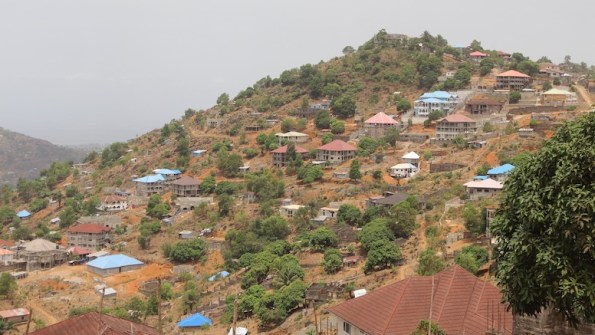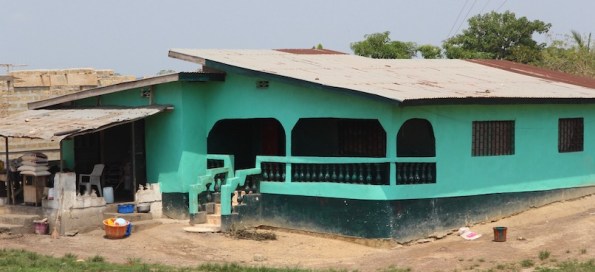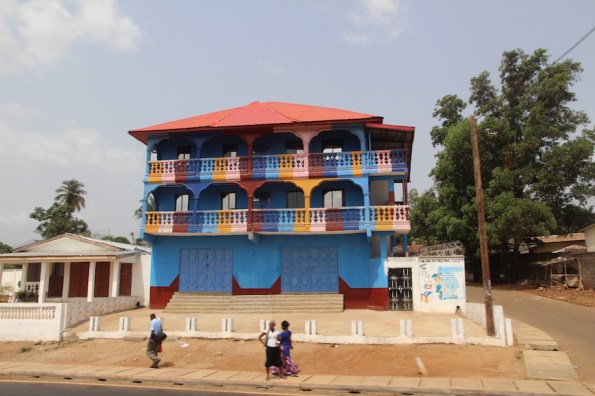African housing ranges from simple to elaborate

Freetown, Sierra Leone—apartment building or house?

On the outskirts of Freetown, Sierra Leone
My last post focused on the simple thatched huts of West Africa, but I don’t want you to think that is the only housing available.
Thatched huts are common in villages, but towns, cities and even larger villages have all sorts of more modern and elaborate homes. Some are really over the top, with fabulous paint combinations or tiled exteriors. Poor John reckons the tile is to minimise mould in the rainy season. Makes sense to me.

House with shop to the left
Some of the homes shown are built over shopfronts or other businesses. Others are apartment buildings.
I thought you’d like to see a variety of the accommodation I snapped from the truck window. We’ve seen a few presidential palaces, but photos weren’t allowed.
P.S. Not many captions.

Shops below

Old-fashioned house in Sierra Leone

Tiled exterior in Labé, Guinea







My guess is that only the very rich, or upper class citizens can afford such nice houses… while the majority of people live in just basic, simply housing with concrete blocks/bricks/mud and/or thatched roof homes….
LikeLiked by 2 people
Wealth is not the only factor. Some houses are built by people who have gone abroad to work and sent money back home.
LikeLiked by 2 people
These are gorgeous homes – fanciful, creative, and I suspect not restricted by homeowner association rules. I really like the wide over-hanging roofs – practical in heat. I’d like to do that to my Southern California home. The gray house in Sierra Leone looks a great deal like a very famous old wooden synagogue that used to exist in Poland, pre-WWII.
LikeLiked by 1 person
I think that grey house is my favourite. Speaks of older times. Also partial to purple. haha
LikeLiked by 1 person
Ah, roofs, one my favourite topics 👍
A roof can accentuate or destroy a house
It’s all about angles, the higher the pitch, the more water it sheds, (this also applies to thatched roof)
It depends on the style of the house as well, a lot of Victorian and Georgian house had flat roofs (that weren’t actually flat, they had a slight pitch of 5-8 degrees to allow the water to flow away, this was usually hidden by a parapet, it gave the illusion of a flat roof
45 degrees is not highly used, it might be just 3-4 degrees steeper but it makes all the difference
The majority of new house are at 50 degrees pitch, because it uses the right amount of materials, any lower the rain wouldn’t flow off fast enough, any steeper, it wouldn’t look right (it would look like a ski slope)
The gutters have to be taken in to account with a roof, it has to be larger if the pitch is greater than 48 degrees because the water flows faster
With a lower pitch roof 30-48 degrees) the water flows slower so the gutter fills slower
A good builder will employ an architect to design the ideal roof, that matches the house, it should compliment the house, bungalow, even a lot of thought, trial and error goes into a village mud hut with a thatched roof, too shallow the water doesn’t flow off, it comes through, too steep it flows too fast and creates puddles (they never have guttering)
So next time look at a roof, does it look right for the building ?
Would you want it steeper or shallower ?
Many times a builder has had to remove and replace a roof, just because it ‘didn’t look right’
These days with computer simulations this is very rare
LikeLiked by 3 people
Oh Derrick, you always provide such useful comments. Luckily, I’ve been schooled about roof pitch. Meaning I know what looks right.
LikeLike
That last one is quite something!
LikeLiked by 1 person
Glad I managed to get a pic of it.
LikeLike
Some very interesting and appealing styles, Peggy. Those corrugated iron roofs must be unbearably noisy during the rainy season though. 🙂 Like living under someone drumming!
Best wishes, Pete.
LikeLiked by 2 people
Maybe they have good insulation underneath to soften the noise.
LikeLiked by 2 people
Actually, ours didn’t. It was termed a “wood and iron” structure. It was a short term project whilst Grandad built the new “proper” house.
I still love the sound of rain on my carport.
LikeLike
A nice balancing post
LikeLiked by 2 people
Thanks Derrick. I thought it was important to show both sides.
LikeLiked by 1 person
That grey house – the older one – is very like some of the older Queenslanders. Built off the ground to help air circulation. But then air conditioners became available and houses were built on the ground. And get flooded and infested with snakes and cane toads.
But I do love the exuberant use of colour.
LikeLiked by 1 person
The grey one instantly reminded me of old Queenslanders. Such an efficient design. I love the colours too.
LikeLiked by 1 person
Wow. Love some of the colours of the exterior paint. Obviously there is some wealth in all the bigger towns/cities…
LikeLiked by 1 person
An early sign of wealth in a community is when people get sheep over goats or cattle over sheep.
LikeLiked by 1 person
Quite a colorful collection but my favorite is the grey old fashioned one!
LikeLiked by 1 person
My favourite too.
LikeLike
This being Cinco de Mayo, the colorful paint schemes remind me of the Mexican proclivity to use bright colors in many ways! Thanks for showing us how the better-fixed live in Africa, too. Nice!
LikeLiked by 1 person
Wishing you a happy and colourful Cinco de Mayo.
LikeLike
Thanks! I had to substitute a single malt 12 year old scotch for tequila, but i survived! LOL!
LikeLiked by 1 person
Glad to hear it.
LikeLike
Those paint schemes are really something!
LikeLiked by 1 person
I hope house painters make a good living.
LikeLiked by 1 person
Everything is so colourful. There’s a big contrast between the villages and the towns. I guess that goes for the people too.
LikeLiked by 1 person
Even some villages have a fancy house or two. I think that’s wealth coming back to the community from overseas.
LikeLike
It’s good to see that wealth can spread. I saw a documentary once that said that the western world was deliberately keeping Africa in poverty by the restriction of fertiliser. The purpose was to use them as our next cheap manufacturer – I don’t know how much truth there was in it, but it was thought provoking at the time.
LikeLiked by 1 person
Sadly, a lot of the West isn’t doing as much as it could to help Africa get ahead.
LikeLike
We moved into a purple house when I was teaching in Gboveh High School in Gbarnga. It didn’t take long for me to break out the whitewash. My paintbrush was a broom. 🙂
LikeLiked by 1 person
Yep, a broom makes a great paintbrush and explains why paint gets everywhere besides the places it is supposed to be. haha
LikeLike
Very interesting building techniques.
LikeLiked by 1 person
Glad you noticed the building styles.
LikeLike
Love the colours. How beautiful. Was going to comment on the rich/poor divide but I don’t think there’s a country in the world immune from that.
LikeLiked by 1 person
Yes, rich and poor live in all countries.
LikeLiked by 1 person
They add such color to what appears to be a pretty drab landscape.
LikeLiked by 1 person
The rains will start soon and then the green takes over.
LikeLike
I love that old-fashioned house in Sierra Leone! Something about the overhanging porch and the covered stairs make me think of magical goings-on… 🙂
LikeLiked by 1 person
I look forward to you weaving that house into your future writings.
LikeLiked by 1 person
Very colorful houses, like the clothes of African women))) Thanks for the exchange!
LikeLiked by 1 person
You are most welcome. Africa really does know how to use colour.
LikeLike